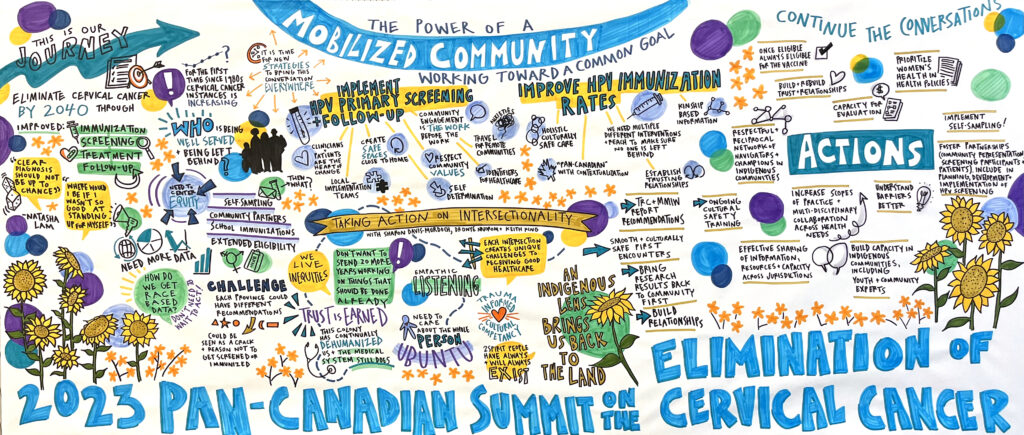2023-24 Annual report
Eliminating cervical cancer by 2040
Every year, more than 1,300 people in Canada are diagnosed with cervical cancer and more than 400 die from it. Canada has made a bold pledge to eliminate cervical cancer, with a plan to accomplish this by 2040.
CPAC has continuously advanced efforts to implement HPV vaccination, HPV primary screening and post-screening follow-up since Canada launched the Action Plan for the Elimination of Cervical Cancer in 2020. By immunizing more people against human papillomavirus (HPV), making it easier for people to screen for the virus and improving how we follow up after positive HPV tests, the viral infections responsible for most cervical cancer can be largely prevented, and cases can be caught early for treatment.
This year, CPAC convened a national summit to share best practices and identify shared priorities to eliminate cervical cancer. With our support, 12 provinces and territories are taking steps to make the switch from Pap tests to HPV screening, a critical component of eliminating cervical cancer.
A national summit for cervical cancer action and equity
In November 2023, CPAC drove significant action to eliminate cervical cancer by convening a national summit in Halifax. The meeting brought together 180 decision-makers to accelerate momentum and discuss the key steps for realizing our collective goal.

Attendees represented every province and territory, spanning diverse interests that included First Nations, Inuit and Métis leaders and other equity-denied populations, immunization and screening programs, cancer agencies, clinician groups, researchers and people with lived cervical cancer experience.
Only by fully understanding the barriers to meeting the action plan’s targets and the strategies that have been supporting success can partners orchestrate a coordinated, collaborative effort to eliminate cervical cancer once and for all. With key voices present, the summit identified nine immediate actions that attendees could take to move the needle toward our collective goal. The most important for reaching our 2040 target are to:
- Co-create and implement culturally appropriate cervical cancer prevention, screening and care with and for equity-denied populations and First Nations, Inuit and Métis
- Expand eligibility for the HPV vaccine across the country
- Urgently shift to HPV screening, including using self-screening techniques
Sustained, collective efforts on the action plan, coupled with high coverage of HPV immunization (90 percent) and HPV testing can prevent 6,810 cervical cancer cases by 2050 and save 1,750 lives.
Reaching immunization targets
With CPAC funding, the Urban Public Health Network (UPHN) completed its initial work to identify the barriers that prevent many populations from becoming immunized against HPV. This has informed two important bodies of work:
- The Public Health Agency of Canada’s National Advisory Committee on Immunization, whose HPV working group is creating updated guidance on HPV vaccines
- A recent white paper by the Federation of Medical Women of Canada’s HPV Taskforce that addresses low rates of HPV immunization in Ontario
To reach young people who have yet to benefit from HPV immunization, we signed a new four-year funding agreement with UPHN to co-develop and implement innovative, community-based strategies with partners from public health, equity-denied populations and First Nations, Inuit and Métis. This will help reach the target of immunizing 90 percent of 17-year-olds by 2025 and continue to expand coverage across the country, especially among those experiencing the greatest barriers.
Removing barriers to HPV screening
HPV screening is critical to achieving Canada’s elimination goals, as the HPV test can identify individuals at increased risk of cervical cancer earlier than the Pap test, resulting in the lower likelihood of developing cancer. CPAC continued this year to support six partners to advance planning and implementation of HPV primary screening: Northwest Territories, Saskatchewan, Manitoba, Nova Scotia, Prince Edward Island, and Newfoundland and Labrador.
In 2023, with CPAC support, Prince Edward Island became the first province to offer province-wide HPV screening. By April 2024, approximately 2,600 tests had been completed. British Columbia launched a province-wide self-screening program in 2024 for individuals aged 25 to 69, making cervical cancer screening more accessible.
Currently, 12 provinces and territories are taking steps towards implementation of HPV primary screening, seven of which are planning for self-screening. Discussions are underway with these partners to sustain the momentum through the next phase of HPV primary screening implementation.
CPAC is also funding the first organized cervical cancer screening initiative in the Northwest Territories, with HPV primary screening as the focus. Through this project, cervical screening partners continue to build relationships with First Nations, Inuit or Métis across the Northwest Territories to identify equity-driven, culturally safe, trauma-informed approaches that support access to HPV self-screening and improve health outcomes within communities across the region.
Releasing new practice guidelines
With progress in primary HPV screening, there will be a short-term surge in colposcopy demand. To prepare for this demand and ensure appropriate and timely follow-up and care, CPAC is supporting and encouraging provinces and territories to include follow-up pathways as an essential part of their transition to HPV primary screening.
With support from CPAC, the Society of Gynecologic Oncology of Canada and the Society of Canadian Colposcopists released guidelines on the management of a positive HPV test and risk-based colposcopy and surveillance. The guidelines complement approaches already in use by cancer agencies and programs, and can also serve as a roadmap for those still developing clinical resources. They include recommendations to better support people who face barriers – such as 2SLGBTQIA+ individuals; First Nations, Inuit and Métis; and newcomers to Canada – and provide culturally safer and appropriate follow-up care after a positive test result.
Highlighting partner progress
CPAC developed a new resource that shares Canada’s progress toward its goal to eliminate cervical cancer. The resource helps to build accountability among partners as well as track progress. It includes a strong focus on achieving health equity and prioritizing actions identified by First Nations, Inuit and Métis. It also includes stories of progress, and videos and quotes, which highlight how partners are working toward eliminating cervical cancer.
